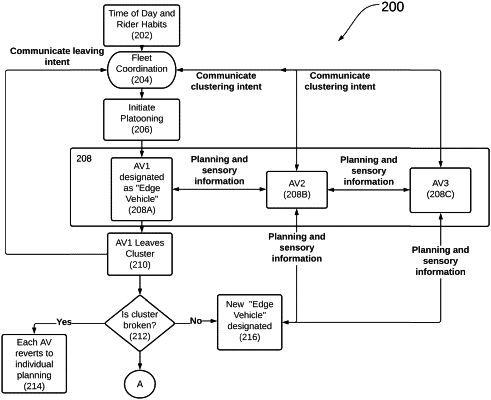| CPC G08G 1/22 (2013.01) [G08G 1/096811 (2013.01); G08G 1/202 (2013.01)] | 20 Claims |

|
1. A fleet coordination system comprising:
one or more processors; and
a computer-readable medium coupled to the one or more processors, wherein the computer-readable medium comprises instructions that are configured to cause the one or more processors to perform operations comprising:
computing navigation routes for each of a plurality of autonomous vehicles (AVs);
identifying a route overlap for a first AV and a second AV selected from among the plurality of AVs;
transmitting a clustering instruction to the first AV and the second AV based on the route overlap, wherein the clustering instruction is configured to cause the first AV and the second AV to initiate a clustering arrangement;
designating the first AV as an edge vehicle based on the first AV's location within the clustering arrangement, wherein designating the first AV as the edge vehicle triggers the first AV to perform all of the perception tasks and all of the planning tasks for both the first AV and the second AV to lower an average energy demand of each of the plurality of AVs within the clustering arrangement;
receiving an instruction that the first AV intends to leave the clustering arrangement;
determining that when the first AV leaves the clustering arrangement, the clustering arrangement will be broken;
triggering, after determining that the clustering arrangement is broken, the first AV to stop performing all of the perception tasks and all of the planning tasks for the second AV; and
triggering the second AV to revert to performing all of its own respective perception functions and all of its own planning functions.
|